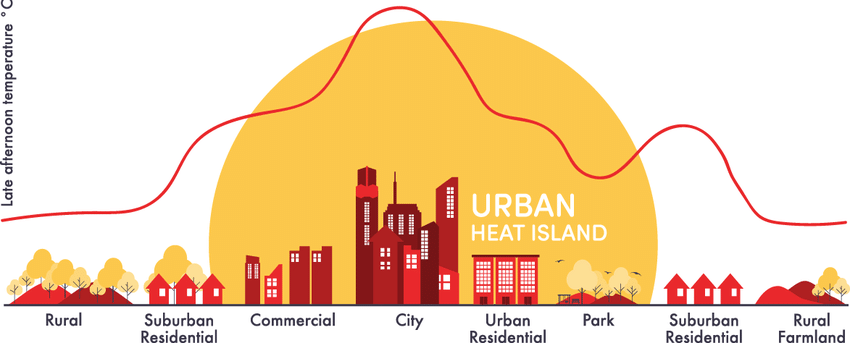ForumIAS announcing GS Foundation Program for UPSC CSE 2025-26 from 19 April. Click Here for more information.
ForumIAS Answer Writing Focus Group (AWFG) for Mains 2024 commencing from 24th June 2024. The Entrance Test for the program will be held on 28th April 2024 at 9 AM. To know more about the program visit: https://forumias.com/blog/awfg2024
Contents
Source: TOI
Syllabus: GS1 – Geophysical Phenomenon, GS3 – Environment,
Relevance: Important geographical phenomenon impacting temperature and climate of a region, the impact of urbanization on the environment
Introduction
Recently, the Centre for Atmospheric Sciences, IIT Delhi, analyzed changes in the land use and land cover pattern over the last five decades based on Delhi’s maps between 1972 and 2014. The aim was to determine how urbanization had impacted the urban heat island effect in the Central National Capital Region.
Key findings
- The urban heat island effect makes localities hotter than others due to factors like concretization, population density, and the density of the land-use area.
- On average, Delhi’s near-surface temperature has increased by 1.02oC due to an increase in urban-land use from 1970 to 2010s.
What is an urban heat island?
An urban heat island (abbreviated as UHI) is where the temperature in a densely populated city is as much as 2 degrees higher than suburban or rural areas.
Heat islands can occur year-round during the day or night. Urban-rural temperature differences are often largest during calm, clear evenings. This is because rural areas cool off faster at night than cities, which retain much of the heat stored in roads, buildings, and other structures. As a result, the largest urban-rural temperature difference, or maximum heat island effect, is often three to five hours after sunset.
The major cause behind UHI
- This happens because of the materials used for pavements, roads, and roofs, such as concrete, asphalt (tar), and bricks. Materials are opaque, do not transmit light, but have a higher heat capacity and thermal conductivity than rural areas, which have more open space, trees, and grass.
- The lack of evapotranspiration in the city leads to the city experiencing higher temperatures than its surroundings.
- Evapotranspiration: Evaporation involves the movement of water to the surrounding air, and transpiration refers to the movement of water within a plant and a subsequent lot of water through the stomata (pores found on the leaf surface) in its leaves. Grass, plants, and trees in the suburbs and rural areas do this.
Other factors behind UHI
- Close construction: When houses, shops, and industrial buildings are constructed close together, it can create an Urban Heat Island. Building materials are usually very good at insulating, or holding in heat. This insulation makes the areas around buildings warmer.
- Waste heat from vehicles, factories, and air conditioners may add warmth to their surroundings, further exacerbating the heat island effect
- Building of skyscrapers: When there is no more room for an urban area to expand, engineers build upward, creating skyscrapers. All this construction means waste heat—and heat that escapes insulation has nowhere to go. It lingers in and between buildings in the UHI.
- Urban haze—The haze of air pollution that hangs over many cities can act as a miniature greenhouse layer, preventing outgoing thermal radiation (heat) from escaping from urban areas.
Impact of UHI
- Energy costs: Urban Heat Island effect increases energy costs (e.g., for air conditioning), air pollution levels, and heat–related illness and mortality. Increased consumption of air-conditioning for cooling can also contribute to global warming, which further contributes to climate change.
- Poor air quality: UHIs often have lower air quality because there are more pollutants (waste products from vehicles, industry, and people) being pumped into the air. These pollutants are blocked from scattering and becoming less toxic by the urban landscape: buildings, roads, sidewalks, and parking lots.
- Poor water quality: Water quality also suffers. When warm water from the UHI ends up flowing into local streams, it stresses the native species that have adapted to life in a cooler aquatic environment.
- Colonization by heat-loving species: Due to higher temperatures in urban areas, the UHI increases the colonization of species that like warm temperatures, such as lizards and geckos. Insects such as ants are more abundant here than in rural areas; these are referred to as ectotherms.
- Heatwaves: Cities tend to experience heat waves that affect human and animal health, leading to heat cramps, sleep deprivation, and increased mortality rates.
Possible solutions to Urban Heat island effect
- Green roofs: Using green roofs, which are roofs of buildings covered in plants, helps cool things down. Using light-colored concrete (using limestone aggregates along with asphalt (or tar) making the road surface greyish or even pinkish (like some places in the US have done); these are 50% better than black since they absorb less heat and reflect more sunlight. Likewise, we should paint rooftops green, and install solar panels there amidst a green background.
- Planting trees: We should plant as many plants and trees as possible. They combat climate change; clean the surrounding air by absorbing pollutant gases (NXOy, O3, NH3, SO2, and others) and trapping particulates on their leaves and bark; cool the city and the streets; conserve energy (cutting air-conditioning costs by 50%); save water and help prevent water pollution; help prevent soil erosion; protect people and children from UV light, etc.
UPSC Mains 2013 – GS1: Bring out the causes for the formation of heat islands in the urban habitat of the world (5 marks, 100 words)
| Also Read: What is a Heat Dome? |





